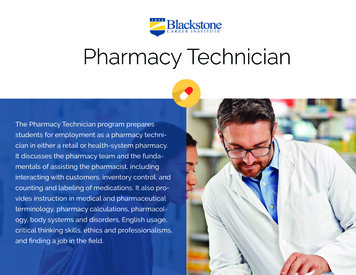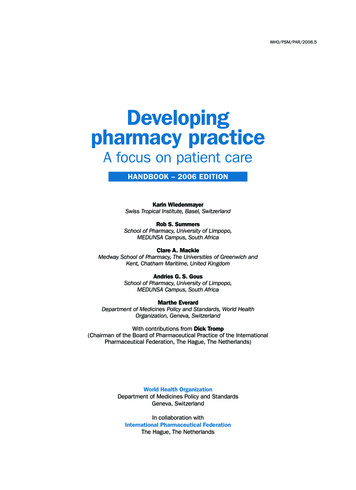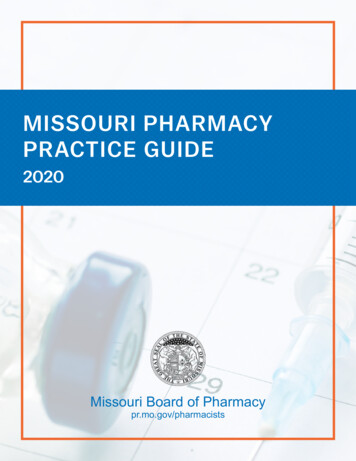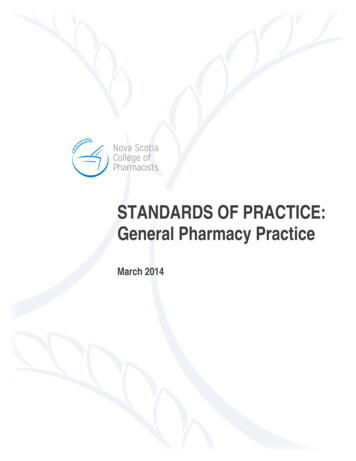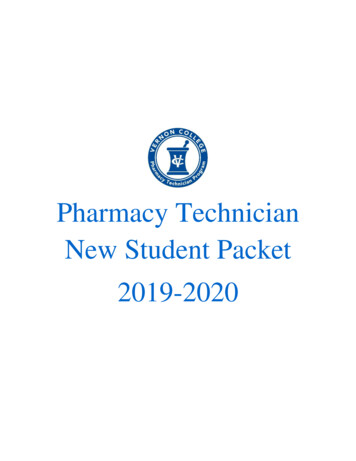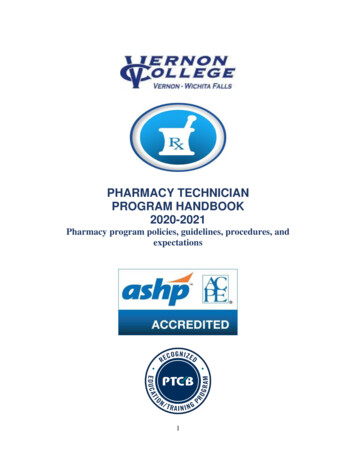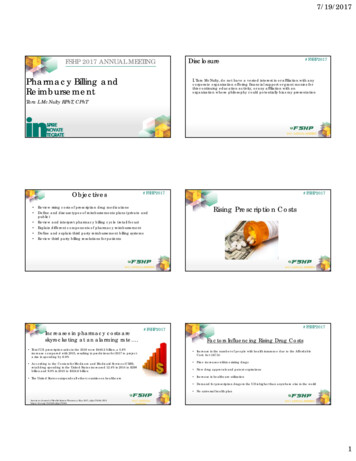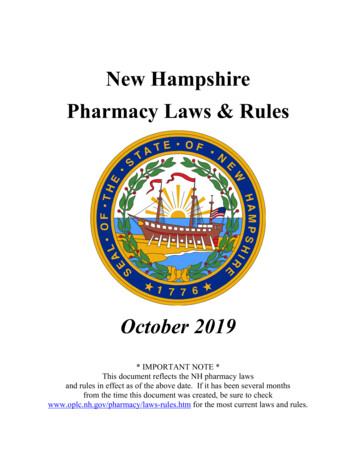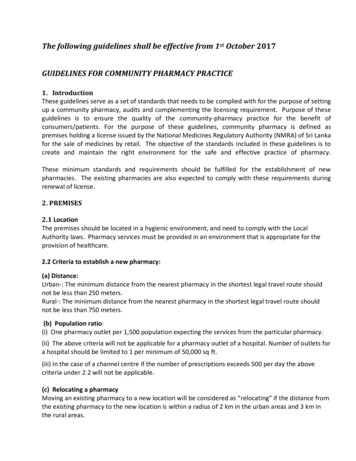
Transcription
The following guidelines shall be effective from 1st October 2017GUIDELINES FOR COMMUNITY PHARMACY PRACTICE1. IntroductionThese guidelines serve as a set of standards that needs to be complied with for the purpose of settingup a community pharmacy, audits and complementing the licensing requirement. Purpose of theseguidelines is to ensure the quality of the community-pharmacy practice for the benefit ofconsumers/patients. For the purpose of these guidelines, community pharmacy is defined aspremises holding a license issued by the National Medicines Regulatory Authority (NMRA) of Sri Lankafor the sale of medicines by retail. The objective of the standards included in these guidelines is tocreate and maintain the right environment for the safe and effective practice of pharmacy.These minimum standards and requirements should be fulfilled for the establishment of newpharmacies. The existing pharmacies are also expected to comply with these requirements duringrenewal of license.2. PREMISES2.1 LocationThe premises should be located in a hygienic environment, and need to comply with the LocalAuthority laws. Pharmacy services must be provided in an environment that is appropriate for theprovision of healthcare.2.2 Criteria to establish a new pharmacy:(a) Distance:Urban-: The minimum distance from the nearest pharmacy in the shortest legal travel route shouldnot be less than 250 meters.Rural-: The minimum distance from the nearest pharmacy in the shortest legal travel route shouldnot be less than 750 meters.(b) Population ratio:(i) One pharmacy outlet per 1,500 population expecting the services from the particular pharmacy.(ii) The above criteria will not be applicable for a pharmacy outlet of a hospital. Number of outlets fora hospital should be limited to 1 per minimum of 50,000 sq ft.(iii) In the case of a channel centre if the number of prescriptions exceeds 500 per day the abovecriteria under 2.2 will not be applicable.(c) Relocating a pharmacyMoving an existing pharmacy to a new location will be considered as “relocating” if the distance fromthe existing pharmacy to the new location is within a radius of 2 km in the urban areas and 3 km inthe rural areas.
2.3 Signboard & AdvertisementsPharmacy signboard must project the professional image of a pharmacy. The logo permitted by theNMRA should be displayed for easy identification. No medicinal advertisement is permitted in anypharmacy signboard. This applies to signboards of both existing and new pharmacy businesses. Anyposters or product advertisements displayed to public must be in accordance with the relevantregulations/guidelines of NMRA.“No Smoking” signs must be displayed prominently to promote healthy lifestyle.2.4 Infrastructure requirements General(c) Adequate parking facilities(d) Accessibility for wheelchairs(e) Access to washing and toilet facilities(f) Adequate lighting to reduce risk of medication errors(g) Acceptable noise level may have soft background music(h) Air-conditioned regular maintenance of air-conditioner(s) to ensure the stability of medicinesand for the comfort of staff and customers(a) Pharmacy area Should be at least 180 sq ft (This area would be varied with the designated additional servicesprovided). All pharmacies are expected to fulfill this criteria within 3 years from 1st January2018. Should display the license issued by the National Medicines Regulatory Authority and thelicense of the Superintendent Pharmacist issued by the Sri Lanka Medical Council.(i) Should consists of: A waiting area - minimum of 60 sq ft with seating facilities for at least 3 people. A Separate lockable area with a minimum of 60 sq ft for storage and dispensing ofSchedule II and III medicines. This area should be kept closed when there is no pharmaciston duty. All pharmacies are expected to comply with this requirement within the year2018. A separate area for Schedule I medicines and other merchandise. Items available for sale should not interfere with the maintenance of hygienic environmentof the pharmacy. A pharmacy within a facility/supermarket/shopping complex/ business center/ multistorybuilding should be at least 75 ft away from the storage areas of meat, fish etc. so thatexposure of such items would not affect the hygienic environment of the pharmacy.(b) Medicine Dispensing Area/ Prescription Counter Medicines should be displayed in a neat and tidy manner projecting a professional image. Size and organization of this area should be adequate for the volume of work. Should enable safe and efficient workflow. Pharmacist should be able to maintain direct supervision of the pharmacy and staff fromthis area. Preferably without any barrier to facilitate effective communication with the patient, butshould facilitate confidentiality where necessary. A separate window /counter should beprovided for this purpose.
(c) A separate counseling area (Optional) A properly designated area with a minimum of 40 sq ft for counseling, which is private andcomfortable. If it is a room, the door should be made of half glass.(d) Additional Services (optional)The types of services offered should be displayed clearly inside the premises.Examples of such services are: Extemporaneous preparations Health screening e.g.-: blood Glucose Test, Electronic blood pressure monitoring Other service(s) such as home care, smoking cessation etc. may be displayed subject toapproval of NMRA2.5 Facilities(a) Refrigerator (preferably a medical refrigerator ) Should be maintained at temperature between 2 – 8oC. Daily temperature reading must be recorded and certified. Temperature records must be properly maintained and available for inspection Appropriate action should be taken to rectify any problems identified The refrigerator used for the storage of medicines should not have any food or drink(b) Medicines Preparation Area A separate washbasin with water supply should be available.(I) “Dry Compounding Area” A designated area with a minimum area of 12 sq ft for counting tablets/ capsules, filling andpacking of medicines and for labeling the prepared medicines Should be away from food and drink Should provide suitable and hygienic means for counting tablets/capsules (e.g. counting tray)(II) “Wet Compounding Area” (optional)(For the purpose of extemporaneous preparations only) A designated area with sink and water supply Minimum of 30 sq ft floor area Should be away from food and drink All working surfaces and shelves should have a smooth impervious surface and washablematerial finishing. Wet compounding area must be equipped with the following:i. Weighing scale - regular calibration by a relevant authority/organization is required to ensurereliability and efficiency.ii. Mortar and pestle - must be maintained in good condition.iii. Tile/glass slabs with spatula - must be maintained in good condition.iv. Measuring appliances - must be maintained in good condition.v. Other required equipment depending on the types of preparation.
(c) Health Screening Area (optional) Equipped with appropriate equipment and devices. Equipment and devices regularly calibrated and in reliable condition at all times.(d) Storage of expired medicines etc. Should adhere to National Medicines Regulatory Authority (NMRA) regulations A segregated area or separate cupboard should be provided to store products which areexpired, recalled, damaged or spoilt. These areas and cupboards should be kept under lockand key. A signboard or a notice should be provided indicating “Expired products, not for sale”. The superintendent pharmacists should take appropriate action to dispose expired medicinesaccording to NMRA regulations.(e) Equipment(i) Computerized system (where available) preferably with the following functions: Pharmacy Information Software Inventory/Stock keeping Printing of labels Printing of customer information leaflets Maintenance of patient medication records Itemized billing Appropriate drug naming system(ii) Printer (where available) preferably with the following functions: For the production of labels, leaflets or any printed materials(d) Cabinets Adequate number of cabinets should be available for the storage of documents / records These should be kept clean and dust free(e) Labels Should be of appropriate sizes and shapes Preferably printed to prevent/ minimize errors due to illegible handwriting NMRA regulations should be followed for labelling of medicines(f) Other RequirementsPantry area for staff (optional)Adequate toilet facilities, clean and in good conditionArrangement must be made for the regular collection and safe disposal of pharmaceuticalwaste and other refuse.2.6 Cleanliness There should be appropriate pest control measures in place Daily cleaning to maintain the pharmacy in a tidy and clean state Written cleaning procedures and schedules should be set out and made available
2.7 Occupational and safety requirements:The premises should be safe for the public and staff working in the pharmacy. Must comply with allstatutory requirements where appropriate: Appropriate fire escape route Fire alarm Fire extinguisher2.8 ReferencesThe following references should be available: British National Formulary All relevant pharmacy legislations. Optional: Martindale-The complete drug reference References for herbal medicines*All information above flow areas of different sections as required are indicated with thesample layout plan in the annexure3. PRACTICE3.1 ServicesEssential services Screening of prescription(s) Dispensing of medicines Compounding of medicines (patient specific) Counseling and advisory Pharmacy management in drug procurement Proper documentation3.2 Type of products70% of the merchandise in a community pharmacy should consist of registered pharmaceuticalproducts, health and nutritional products, surgical and medical devices, personal care andrehabilitation aids.Sale of goods and food which are harmful to health is strictly prohibited (E.g. Cigarettes, liquor etc.).4. Personnel(4.1) Pharmacists Registered with the Sri Lanka Medical Council Comply with all the pharmacy legislations of Sri Lanka Notice and photograph of the pharmacist(s) on duty must be displayed The pharmacist under whose license the pharmacy is registered with NMRA is designated aSuperintendent Pharmacist
Dress codei. Pharmacist White Coatii. Must project a professional imageiii. Name tag must have the word “ Superintendent Pharmacist” or “Pharmacist” asapplicable(4.2) Pharmacy support staff Suitable number The role of the pharmacy support staff is to help in the preparation of medicines to bedispensed. They are not allowed to dispense Schedule II & III medicines. It is the responsibility of the Superintendent Pharmacist to provide required training toPharmacists and Pharmacy support staff5. Storage of medicines All medicines must comply with labeling requirements and should be kept in the originalpackaging or properly labeled containers.Different categories of items should be systematically arranged.Separate storage should be provided for internal and external medicines.Medicines with similar names and packaging should be distinctively separated to preventdispensing errors.Storage conditions must comply with manufacturer instructions and cold chain requirementswhere relevantSchedule II and III medicines- A separate, safe and locked cabinet should be used for storage of psychotropic substancesand dangerous drugs away from other goods/medicines.- All keys of medicine cupboards must be kept by the superintendent pharmacist/seniorpharmacist on duty.5.1 Safety and Quality Improvement Activities Secure locks on main door and grille/gate. Secure locks on back doors and grille/gate if applicable. Entrance should be prohibited in the lockable area during non-working hours. Electronically controlled locks may be utilised. Additional safety control such as video cameras and alarm system areadvisable. Policy for appropriate security should be arranged. To comply with relevant statutory requirements.5.2 Records Records and documentations should be kept and updated systematically as stipulated by thelaw. Documentation - Proper documentation should be maintained to fulfill legal and professionalrequirements.
Preferably, the pharmacy should maintain patient medication records:- To check the progress of the treatment and provide information on the medical historyof the patient.- To be kept in pharmacy computer systems or in manual records.- Should be pertinent, accurate, up-to-date, stored securely and treated as confidentialand used only for the purpose for which it is obtained.5.3 Self-monitoring Devices Pharmacist should give full information to the patients on the use of the self-monitoringdevices and the frequency of measurement. Patients may be asked to perform self-monitoring under the guidance of the pharmacist toensure effective learning of the technique. Encourage patients to document their own results. Help them to understand the results.5.4 Health Screening (optional) All staff involved in providing the above service should be trained in the use of the monitoringdevices and the procedures. They should also be aware of the limits of the tests provided. The pharmacy must have a suitable area with facilities to perform the tests and providecounseling. Ensure that the devices used are in good order. Keep up to date with the latest development and know when to refer patients to medicalpractitioners. Before conducting the test, explain the procedure to the patient. Communicate test results to the patient in a manner in which he/she can understand andprovide appropriate counseling.5.5 Extemporaneous Dispensing Ensure that the formula and intended method of preparation is correct. Requisite facilities and equipment for the preparation are available and maintained in goodorder. Ingredients must be sourced from reliable pharmaceutical supplier and be of a qualityaccepted for use in the preparation of the extemporaneous products. All calculations, ingredients and quantities should be checked by a second person who is apharmacist. Pharmacists must pay particular attention to substances that may be hazardous and requirespecial handling techniques. The product must be suitably labeled with the necessary information, including specialrequirements for the safe handling and storage of the product including an expiry date. Document the preparation and keep the records for at least 2 years. The records must includethe formula, the ingredients and the quantities used, their source, batch number, expiry date,date of preparation and personnel involved in the preparation. All documentations should be certified and duly stamped by a registered pharmacist withhis/her registration number indicated.
5.6 Awareness of original and counterfeit drugs, OTC and herbal supplements Pharmacist should only buy medicines from legitimate sources Pharmacies may use suitable device such as “Meditag reader” in order to ascertain if aproduct is genuine and registered with the NMRA. Pharmacists must educate customers on how to identify counterfeit medicines. Pharmacists must be able to check the registration n of a product through the NMRA website. Pharmacists must be aware of the latest information on de-registered products, productsfound to contain adulterated ingredients, changes to product information approved by NMRAand safety issues.5.7 Health Promotion Health promotion is the process of enabling people to have increased control over, and toimprove their health. Community pharmacists can play a very important role in promoting, maintaining andimproving the health of communities that they serve.
Annexure
Authority laws. Pharmacy services must be provided in an environment that is appropriate for the provision of healthcare. 2.2 Criteria to establish a new pharmacy: (a) Distance: Urban-: The minimum distance from the nearest pharmacy in the shortest legal travel route should not be less than 250 meters.
